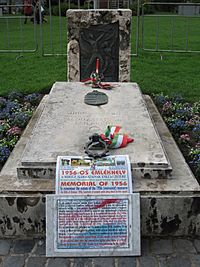Hungarian Revolution of 1956 facts for kids

The Hungarian Revolution of 1956 was a big uprising in Hungary. It happened against the government and its rules, which were set by the Soviet Union. It lasted from October 23 to November 10, 1956. This was the first major challenge to Soviet control since World War II. Even though the uprising didn't succeed, it was very important. It helped lead to the fall of the Soviet Union many years later.
How It All Started
After World War II, Hungary was freed from the Nazis. But then, the Soviet Union's Red Army took control. Hungary's communist leaders, like Mátyás Rákosi, were supported by Joseph Stalin. These communists removed all other political groups.
In 1949, Hungary officially became the People's Republic of Hungary. Rákosi was a very strict leader. He sent over 300,000 Hungarians away, to prison, or even killed them.
After Stalin died, Soviet leaders replaced Rákosi with Imre Nagy. They thought Nagy's softer approach would make people happier. But the Soviet leaders soon felt Nagy was becoming too popular. So, Rákosi was put back in charge in April 1955. His secret police, called the AVO, started their harsh actions again. The Hungarian people became very tired of this communist rule.
When the revolt began in October 1956, it was a sudden event. No single group had planned it. Nobody expected it to spread across the whole country so quickly. However, there were signs that trouble was coming. The Communist Party in Hungary had lost much of its power and respect. In July 1956, Rákosi was removed as leader again. He was sent back to the Soviet Union.
What Happened After the Uprising?
Many Hungarians died during the uprising. Thousands more were put in prison. Hundreds of Soviet soldiers also lost their lives. Over 100,000 Hungarians left the country. They went to countries outside the Eastern Bloc, which was controlled by the Soviet Union. Communists in Western countries disagreed about whether stopping the rebellion was a good idea.
Images for kids
-
Stalin's man in Hungary: Mátyás Rákosi speaks in Budapest, 1948.
-
Dutch people marched in support of the Hungarian Revolution in Eindhoven, Netherlands, on November 5, 1956.
-
Eleanor Roosevelt meets Hungarian revolutionaries who fled their country at Camp Roeder in Salzburg, May 10, 1957.
-
A memorial plaque at the Embassy of Serbia, Budapest for Imre Nagy. He found safety there during the revolution.
See also
 In Spanish: Revolución húngara de 1956 para niños
In Spanish: Revolución húngara de 1956 para niños














